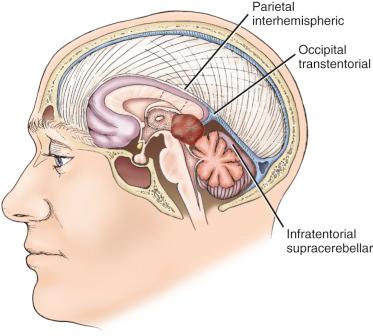Physical Address
304 North Cardinal St.
Dorchester Center, MA 02124
This approach is well suited for midline tumors in the pineal region: germinoma, teratoma, pineocytoma, pineoblastoma, astrocytoma, metastasis, ependymoma, epidermoid tumor, cavernoma ( Figure 8.1 ).

Tumors in the midline tectal region.
Midline pontomesencephalic lesions.
The approach is not optimally suited if the tumor infiltrates laterally or superiorly above the tentorium.
Transcallosal interhemispheric or occipital transtentorial approaches are preferred under the following circumstances:
Tumors that extend superiorly, to the third ventricle or invading the corpus callosum (posterior transcallosal approach).
Tumors that extend laterally, around the fornix.
Tumors that extend inferiorly into the quadrigeminal plate or superior cerebellar peduncle.
Lesions located superiorly to the Galenic venous draining system and displacing the deep venous system in a ventral direction, e.g. meningiomas (occipital transtentorial approach).
Steeply angled tentorium (occipital transtentorial approach).
In tumors extending into the posterior part of the lateral ventricle, on the non-dominant side a transcortical transventricular approach is preferred.
This approach gives access to the midline and the resection can be extended laterally and rostrocaudally. The pineal region, quadrigeminal and ambient cisterns can be exposed through this route, which also gives access to the velum interpositum and the deep venous system. No normal parenchyma is transected en route to the tumor.
Because of the close location to the sylvian aqueduct, obstructive hydrocephalus is commonly present before surgery. CSF diversion may be necessary.
Preoperative MR venography is useful to study the relation between the tumor and the deep venous system and venous sinuses.
The goal of this approach is to achieve maximal relaxation of the cerebellum, with limited use of cerebellar retraction by taking advantage of the gravity.
Become a Clinical Tree membership for Full access and enjoy Unlimited articles
If you are a member. Log in here